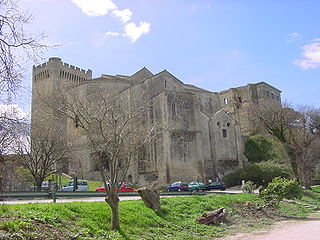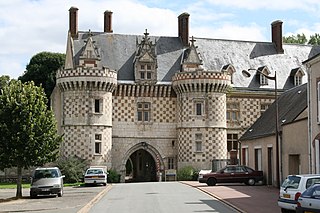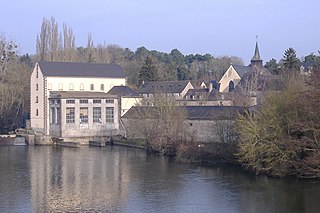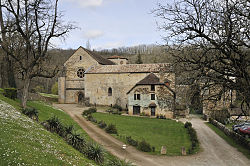
Montmajour Abbey, formally the Abbey of St. Peter in Montmajour, was a fortified Benedictine monastery built between the 10th and 18th centuries on what was originally an island five kilometers north of Arles, in what is now the Bouches-du-Rhône Department, in the region of Provence in the south of France.

Vaux-de-Cernay Abbey is a former Cistercian monastery in northern France (Île-de-France), situated in Cernay-la-Ville, in the Diocese of Versailles, Yvelines. The abbey was abandoned during the French Revolution and fell into partial ruin. Most of the buildings, except for the church, were restored in the late 19th century by Charlotte de Rothschild, and the property is now a hotel.

Bonneval Abbey, also known as St. Florentinus' Abbey, is a former Benedictine monastery in Bonneval, Eure-et-Loir, in France.

The Hôtel de Sully is a Louis XIII style hôtel particulier, or private mansion, located at 62 rue Saint-Antoine in the Marais, IV arrondissement, Paris, France. Built at the beginning of the 17th century, it is nowadays the seat of the Centre des Monuments Nationaux, the French national organization responsible for national heritage sites. It has been listed since 1862 as a monument historique by the French Ministry of Culture.

The Royal Monastery of Brou is a religious complex located at Bourg-en-Bresse in the Ain département, central France. Made out of monastic buildings in addition to a church, they were built at the beginning of the 16th century by Margaret of Austria, daughter of the Holy Roman Emperor Maximilian I and Governor of the Habsburg Netherlands. The complex was designed as a dynastic burial place in the tradition of the Burgundian Champmol and Cîteaux Abbey, and the French Saint-Denis. The church is known as the Église Saint-Nicolas-de-Tolentin de Brou in French.

Charroux Abbey is a ruined monastery in Charroux, in the Vienne department of Nouvelle-Aquitaine, western France.

The architecture of Luxembourg probably extends back to the Treveri, a Celtic tribe who prospered in the 1st century BC. A few ruins remain from the Roman occupation but the most significant contributions over the centuries have been the country's castles and churches. Today there is a veritable architectural boom as Luxembourg's economic prosperity provides a basis for developments in the financial, EU and cultural sectors with a number of world-class buildings.

Maubuisson Abbey is a Cistercian nunnery at Saint-Ouen-l'Aumône, in the Val-d'Oise department of France. It was founded in A.D. 1236 by Blanche of Castile, Queen of France, who may have been buried there in 1252. The site is now within the north-western suburbs of Paris. The surviving buildings are listed as a monument historique.

Moissac Abbey was a Benedictine and Cluniac monastery in Moissac, Tarn-et-Garonne in south-western France. A number of its medieval buildings survive, including the abbey church, which has a famous and important Romanesque sculpture around the entrance.

Val-Saint-Lambert Abbey was a Cistercian abbey in the Prince-Bishopric of Liège. It is situated in the Walloon municipality of Seraing, on the right bank of the Meuse, in Belgium, about 13 km (8.1 mi) south-west of Liège. Founded in 1202, the abbey's monks were expelled during the French Revolution. In the 19th century, the building ruins were converted into the Val Saint Lambert crystal factory. The structure is considered to be an important example of Cistercian architecture.

Port-du-Salut Abbey, also the Abbey of Notre-Dame du Port du Salut is a Trappist monastery located in Entrammes, Mayenne, France. The main monastery building dates from around the 13th century.

Bassac Abbey is a former Benedictine monastery in Bassac, Charente, France, in the former diocese of Saintes.

The Abbey of Saint-Seine is a former Benedictine monastery located in Saint-Seine-l'Abbaye, Côte-d'Or, Burgundy, France. During the Middle Ages it was a wealthy and powerful institution. It was suppressed at the French Revolution.

The Abbey of St. Sergius, more fully the Abbey of Saints Sergius and Bacchus, in Angers was a Benedictine monastery in France.

The Abbey of St Paul, Verdun, is a former Premonstratensian monastery in Verdun, department of Meuse, Grand Est region, France. The surviving buildings are used for civic purposes.

Solignac Abbey, or the Abbey of Saint-Peter and Saint Paul of Solignac, is an abbey in Solignac, near Limoges, in Haute-Vienne. It was founded around 631 AD by Saint Eligius (Éloi). The present buildings date to the 12th century, but have been modified many times since then. The abbey was dissolved during the French Revolution and the buildings were put to new uses, including a prison, boarding school, porcelain factory and seminary. As of 2021 there were plans to restore it back to its original function as a monastery.

La Joie Abbey, also the Abbey of La Joie-Notre-Dame, is a former Cistercian abbey on the territory of Hennebont. It was part of the diocese of Vannes. Today, it is the site of the national stud farm.

Beaugerais Abbey is a former Cistercian abbey, located in what is now the commune of Loché-sur-Indrois, in the Indre-et-Loire département of France.

















